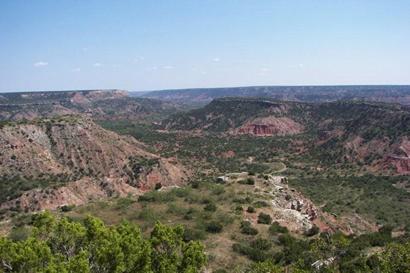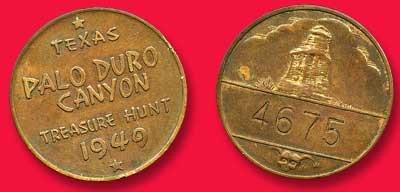|
Once
upon a time, a shower of shiny gold coins fell from the sky over Palo
Duro Canyon State Park south of Amarillo.
No, really. This isn’t a fairy tale. That actually happened one Saturday
in the late spring of 1949, a decade and a half after the scenic and
history-rich Panhandle park opened to the public on July 4, 1934.
Of course, the coins that rained down on the canyon that day were
only brass with gold-looking plating called “goldine.”
Even so, the metallic manna-from-heaven-style event drew a big crowd
to the rim of the canyon and may have netted two lucky people all-expense-paid,
eight-day vacations to Havana, Cuba. That was back during the long
dictatorship of President Fulgencio Batista when Havana was a wide-open
party town controlled by the American mafia.
On
May 28, 1949, an airplane flew over the nation’s second-largest canyon
and dropped 10,000 coins over the park,
which then covered some 16,000 acres and now includes nearly 30,000
acres. A thousand of the coins would be redeemable for prizes collectively
valued at $10,000. |
 |
Once the coins
had been dropped, Gov. Beauford H. Jester cut a ribbon at the entrance
to the canyon
to trigger a 20th century “gold” rush and the earliest large-scale
effort to position the canyon
as a major Panhandle
tourist destination.
Park
officials were bracing for a turnout of 100,000 people that day, but
whether that large a crowd actually showed up was not reported. No
matter the number, the driver of each car entering the park had to
pay 42 cents, plus 24 cents for any additional adult in the vehicle.
Children got in for 12 cents.
As soon as the visitors could drive down to the floor of the canyon
and get their cars parked, the treasure hunt began. What they hoped
to find was a coin that on one side bore the legend “Texas Palo
Duro Canyon Treasure Hunt 1949.” The other side featured a raised
image of the park’s
most famous landmark, the towering rock formation called the Lighthouse.
A number had been stamped across the lower part of the Lighthouse
near the bottom of the coin. All the coins with numbers ending in
seven netted the finder a prize if claimed by Labor Day 1949. |
 |
| Courtesy
www.palodurocanyon.org |
"The Lighthouse"
Courtesy rootsweb.com/ %7Etxpstcrd/ |
Other than the
grand prizes, finders had a shot at season passes to Amarillo
Gold Sox home games; a $250 diamond ring donated by an Amarillo
jeweler; and two registered quarter horses from Panhandle
rancher Glenn L. Casey.
An organization called the Palo Duro Canyon Boosters Club sponsored
the effort. Contemporary newspaper coverage in advance of and after
the event doesn’t reveal whose brainchild this campaign had been,
but whoever dreamed it up hit a public relations homerun. It might
have been F.W. “Fist” Ansley (1899-1979), chairman of the club.
Since Braniff Airways had put up the top prizes, that pioneer aviation
company doubtless played a role in the publicity campaign. In fact,
some PR type at the company’s Dallas
headquarters may well have come up with the idea of cashing in on
the fact that 1949 marked the centennial of the great California gold
rush.
“The Palo
Duro ‘gold rush’ is being held by the boosters club to solicit
membership and appropriate funds and gifts to advertise Palo
Duro Canyon attractions throughout the country,” read a news release
widely published in Texas newspapers before the event. “A program
of events will be scheduled to attract people to this region and to
draw steady tourist trade to the Panhandle.”
The organization hoped to gain as many new members as the number of
coins dropped from above, each membership costing $1. Whether that
happened was not reported, but given that people are generally more
interested in getting something for nothing than spending a dollar
when that much money could buy nearly a quarter-tank of gasoline,
it’s hard to believe the boosters reached their hoped-for number.
Six decades later, park visitors still occasionally find one of the
coins from the Palo Duro Gold Rush of 1949. Unfortunately, though
nice collectibles, they no longer are redeemable for prizes.
© Mike Cox
"Texas Tales" March
18, 2011 column |
| Books
by Mike Cox - Order Here |
|
|
